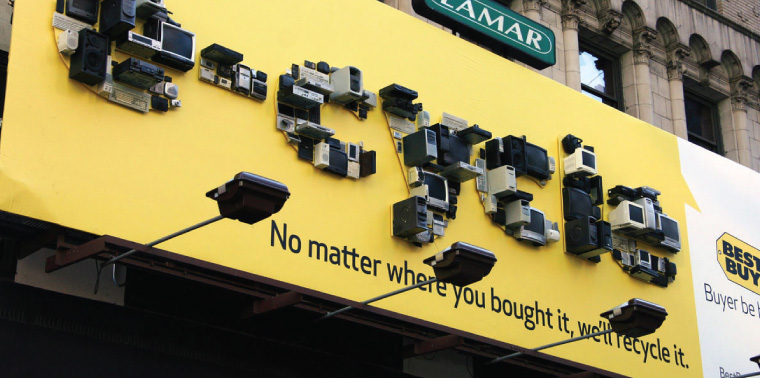April 1, 2013 — Make no mistake: Best Buy likes to see customers lining up for that next new, must-have gadget. The consumer electronics retailer is in the business of helping people upgrade their technology, whether it’s a mobile phone or a big-screen television.
For every new product, though, there’s often an old one made obsolete: last year’s iPhone, or a clunky analog TV set, or that computer your media collection outgrew. All of this stuff eventually starts to pile up in closets, landfills or incinerators.
It’s an environmental hazard, and it’s a customer hassle. That’s why Best Buy is seeking to help close the loop on the millions of pounds of electronic waste its stores and customers generate each year.
Best Buy has rapidly become a national leader in e-waste recycling since launching an in-store drop-off program in February 2009. Customers at its U.S. stores can bring in just about any old electronics, regardless of where or when they were purchased, and Best Buy will make sure they get recycled responsibly. In 2010, the company collected more than 75 million pounds of unwanted electronics.
That may sound like a lot — and it’s no small feat for a program that was only in its second year. But it’s still a molehill next to the mountain of e-waste we’re collectively piling up. Consumer electronics make up one of the fastest-growing waste streams on the planet. The U.S. Environmental Protection Agency estimated that Americans alone jettisoned about 3.2 million tons of electronics in 2009, up from about 1.9 million in 2000. Of this, less than 20 percent was recycled.
Best Buy’s action is more notable because, in general, other members of the consumer electronics industry have done almost nothing to address the problem of e-waste except in states where they are legally required to do so.
That means the vast majority of e-waste is still winding up in landfills or incinerators, where the parts inside can release toxic materials, such as lead, mercury, cadmium and arsenic, into the environment. E-waste also contains a lot of useful commodities, such as glass, metal and plastic, which could be recycled instead of being buried or burned.
“There’s a huge opportunity to bring more of this stuff back in,” says Leo Raudys, Best Buy’s senior director for environmental sustainability.
The retailer is extending the life of some products by collecting and reselling them through trade-in and buy-back programs. But its most visible and successful sustainability effort has been its in-store recycling program, which collects more than 300 pounds of e-waste per minute.
Raudys says they see it all, from old eight-track players and Miami Vice–style brick cell phones to busted printers and worn out video game controllers. The biggest categories by weight are TVs and computers. Other common items include cables and batteries. From the stores, e-waste is sent to one of the company’s four recycling partners, where it’s sorted, stripped, shredded, smashed and smelted into usable products.
Best Buy’s goal is to recycle a billion pounds of consumer electronics by 2014. It’s an admirable target, but watchdog groups are more impressed with Best Buy’s commitment to making sure what it collects is recycled responsibly.
The U.S. lacks significant federal regulation on electronics recycling, which allows companies that claim to be recyclers to get away with simply dumping material as cheaply as possible in poorer countries under the guise that it’s being reused there. The Basel Action Network, a Seattle nonprofit that works on e-waste issues, estimates this is what happens with up to 80 percent of e-waste that’s left with recyclers.
Lauren Roman, business director for Basel’s e-Stewards recycler certification program, says she’s “very pleased” with Best Buy’s recycling efforts. Not only is the company making electronics recycling more accessible, it’s also doing so in a way that’s transparent and responsible. Best Buy annually audits its recyclers, and it won’t work with a company if it or its partners export nonworking products to developing countries.
Best Buy’s action is more notable because, in general, other members of the consumer electronics industry have done almost nothing to address the problem of e-waste except in states where they are legally required to do so, says Barbara Kyle, national coordinator for the Electronics Takeback Coalition.
Best Buy’s recycling program is already operating at slightly better than breakeven because the retailer shares a portion of the revenue its recyclers get from selling the separated materials. Raudys says the company is on pace to make its billion-pound goal by 2014 and is looking to expand the recycling program to its stores in Canada, China and the UK. ![]()
A version of this article originally appeared in the Fall 2011 issue of Momentum magazine, Ensia’s predecessor.
Ensia shares solutions-focused stories free of charge through our online magazine and partner media. That means audiences around the world have ready access to stories that can — and do — help them shape a better future. If you value our work, please show your support today.
Yes, I'll support Ensia!
